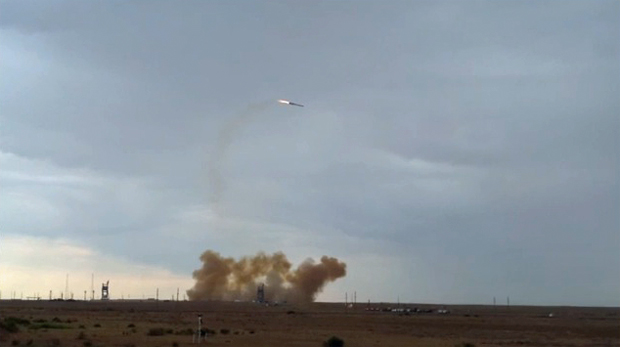Proton crash likely caused by incorrect sensor installation
07/18/2013 11:33 PM Filed in: Space News | Russian Space
By WILLIAM HARWOOD
CBS News
The dramatic failure of a heavy-lift Russian Proton rocket seconds after launch July 2 may have been caused by incorrectly installed guidance sensors in the booster's first stage, according to a statement posted Thursday by Roscosmos, the Russian federal space agency.
Television views of the launching showed the unmanned rocket veering wildly out of control within seconds of liftoff from the Baikonur Cosmodrome in Kazakhstan, swinging to one side and then the other before pitching nose down and breaking apart in a spectacular conflagration.
Lost in the mishap were three Russian Glonass navigation satellites. There were no injuries or significant property damage on the ground.
The Roscosmos statement appears to confirm earlier Russian media reports saying three of six "angular rate sensors" in the first stage control system apparently were installed upside down, or 180 degrees from the proper orientation.
The accident investigation commission organized a search of the wreckage and located the angular rate sensors, which were sent back to the manufacturer for testing.
Three of six rate sensors showed signs of being forced into position that almost exactly matched sensors that were deliberately installed improperly in a test rig during the post-accident investigation.
Alexander Lopatin, deputy head of Roscosmos, said the incorrect installation could have been the result of a worker making an error during assembly or because the rocket's blueprints were wrong, according to Ria Novosti.
"Installing these devices is complicated and awkward work," Lopatin said.
Roscosmos also reported the rocket began lifting off four-tenths of a second earlier than expected, but engineers do not believe the timing issue contributed to the mishap.
The investigation is not yet complete, but the space agency's preliminary conclusion is that the improper guidance sensor installation was the primary cause of the accident.
In addition, investigators found that the rocket's builder, Khrunichev State Research and Production Space Center, did not have quality control and inspection procedures in place to verify the orientation of the sensors.
Procedures will be modified and existing hardware will be inspected to make sure installation problems do not happen again. In the meantime, Proton rockets remain grounded with no word on when they might be returned to flight status.
Protons are used to launch a wide varitey of commercial satellites as well as Russian government payloads. One major payload awaiting launch atop a Proton is a new Russian laboratory module bound for the International Space Station.
Launch is officially scheduled for December, but the flight was expected to slip into next year regardless of the July 2 mishap. Protons presumably will be flying well before the lab module is ready for launch.
CBS News
The dramatic failure of a heavy-lift Russian Proton rocket seconds after launch July 2 may have been caused by incorrectly installed guidance sensors in the booster's first stage, according to a statement posted Thursday by Roscosmos, the Russian federal space agency.
Television views of the launching showed the unmanned rocket veering wildly out of control within seconds of liftoff from the Baikonur Cosmodrome in Kazakhstan, swinging to one side and then the other before pitching nose down and breaking apart in a spectacular conflagration.
 |
| A Russian Proton rocket veers out of control seconds after launch from the Baikonur Cosmodrome in Kazakhstan. (Credit: YouTube) |
Lost in the mishap were three Russian Glonass navigation satellites. There were no injuries or significant property damage on the ground.
The Roscosmos statement appears to confirm earlier Russian media reports saying three of six "angular rate sensors" in the first stage control system apparently were installed upside down, or 180 degrees from the proper orientation.
The accident investigation commission organized a search of the wreckage and located the angular rate sensors, which were sent back to the manufacturer for testing.
Three of six rate sensors showed signs of being forced into position that almost exactly matched sensors that were deliberately installed improperly in a test rig during the post-accident investigation.
Alexander Lopatin, deputy head of Roscosmos, said the incorrect installation could have been the result of a worker making an error during assembly or because the rocket's blueprints were wrong, according to Ria Novosti.
"Installing these devices is complicated and awkward work," Lopatin said.
Roscosmos also reported the rocket began lifting off four-tenths of a second earlier than expected, but engineers do not believe the timing issue contributed to the mishap.
The investigation is not yet complete, but the space agency's preliminary conclusion is that the improper guidance sensor installation was the primary cause of the accident.
In addition, investigators found that the rocket's builder, Khrunichev State Research and Production Space Center, did not have quality control and inspection procedures in place to verify the orientation of the sensors.
Procedures will be modified and existing hardware will be inspected to make sure installation problems do not happen again. In the meantime, Proton rockets remain grounded with no word on when they might be returned to flight status.
Protons are used to launch a wide varitey of commercial satellites as well as Russian government payloads. One major payload awaiting launch atop a Proton is a new Russian laboratory module bound for the International Space Station.
Launch is officially scheduled for December, but the flight was expected to slip into next year regardless of the July 2 mishap. Protons presumably will be flying well before the lab module is ready for launch.